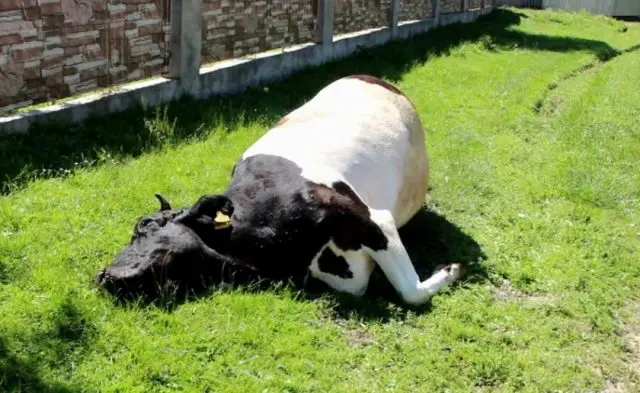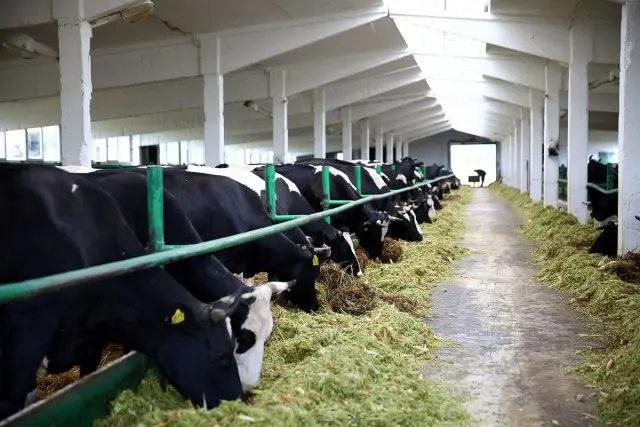Contents
When raising cattle, it is worth paying special attention to young animals, since it is they who are most often susceptible to various kinds of diseases. In addition, the level of productivity of the herd depends on the health of the calves. Lung diseases in cows can cause mass mortality of animals. That is why farmers need to know the signs of diseases in order to identify and eliminate them at an early stage.
Varieties of lung diseases in cattle
To date, there are the following types of lung diseases in cows and calves:
- tuberculosis;
- bronchopneumonia;
- pasteurellosis;
- dictiocaulesis.
If you know the causes and symptoms, then you can overcome the disease at an early stage, as a result of which the animal will not die.
Tuberculosis
Tuberculosis in cattle is a fairly common infectious disease throughout the world, the causative agent of which is Koch’s bacillus. As a rule, this disease affects the lungs, there are cases when tuberculosis develops in other internal organs. Initially, a small nodule appears on the lungs, which over time can lead to tissue necrosis and death.
Causes and symptoms
There are a large number of reasons why an animal developed lung disease:
- the disease was transmitted by airborne droplets;
- the cow was kept in a stall after a sick animal;
- bacterium brought from pasture;
- the causative agent of tuberculosis is in the general watering place;
- the carrier is a pet.
In addition, lung disease can appear if cows are kept in cramped stalls, and unsanitary conditions reign on the farm.
Symptoms of tuberculosis include:
- frequent breathing
- dyspnea;
- decreased appetite;
- sharp weight loss;
- skin is dry, inelastic;
- elevated temperature;
- mucus is released during coughing;
- wheezing.
When these symptoms appear, it is recommended to take samples and conduct a study to identify the causative agent of the disease.
Therapies
One of the most common lung diseases in cows is tuberculosis. Unfortunately, today there are no drugs against this disease, so it is almost impossible to cure a sick animal.
Since this disease is not treated, it is recommended to carry out health work in the herd:
- it is necessary to periodically take samples and conduct laboratory tests to identify infected cows (sick animals are sent for slaughter);
- if lung disease is found in all animals, it will be necessary to completely replace the herd.
If a new herd is acquired, then appropriate samples should also be taken from the animals.
Bronchopneumonia
Bronchopneumonia in cattle is a non-contagious form of the disease, that is, the lung disease has appeared as a result of improper management of the animal. This includes hypothermia of the body, as a result of which inflammatory processes began to occur, which, in turn, began to affect the bronchi. After that, the process of spreading to other respiratory organs begins.
Causes and symptoms
There are a large number of reasons why a cow developed a lung disease, namely, bronchopneumonia:
- the animal stays in a small room;
- there is no ventilation system and the air is saturated with hydrogen sulfide;
- low temperature, high humidity, no bedding;
- a large amount of stress;
- poor quality food.
Symptoms include the following:
- lethargy;
- loss of appetite;
- temperature increase;
- dyspnea;
- dry cough;
- swelling on the nasal mucosa;
- discharge of pus from the nose;
- weight loss.
If these symptoms are detected, it is recommended to immediately diagnose the disease.
Therapies
Despite the fact that bronchopneumonia has been studied quite well (a lung disease in cows and calves), there is still no single method of treating this disease. Depending on the form of the leak and its severity, you can resort to the following methods of therapy:
- traditional – an infected calf or cow is separated from the main herd, provided with a dry and clean place, increased diet and includes much more vitamins and mineral-based supplements;
- etiotropic – the essence of this method of treatment is that they create a high level of concentration of drugs in the body, which directly affects inflammatory processes;
- intratracheal – this method of therapy assumes that a cow with a lung disease will be injected with drugs using a probe into the trachea;
- aerosol – in the room where the sick calves are located, the active substances are sprayed.
Experienced veterinarians recommend using several types of treatment at once.
Pasteurellosis
Pasteurellosis is one of the dangerous types of disease in cattle, leading to death in just a couple of days. It is important to consider that this disease spreads quite quickly and can affect not only domestic animals and birds, but also the person himself. That is why it is so important to recognize this disease in the early stages and take measures to eliminate it.

Causes and symptoms
The causative agent of this disease can be in water or soil for many years and enter the body of an animal through food, water, care items, bedding, and in contact with other animals. Factors in the development of the disease include:
- poor sanitary conditions;
- irregular feeding process;
- barn of small size.
Symptoms include:
- increased body temperature;
- prostration;
- lack of milk;
- frequent breathing
- rapid pulse;
- loss of appetite;
- diarrhea;
- labored breathing;
- discharge of pus from the nose;
- thirst;
- edema.
To distinguish this type of disease from others, it is necessary to conduct a comprehensive analysis.
Therapies
An infected animal must be immediately isolated, placed in a warm and dry room equipped with a ventilation system. The food should be balanced, contain a large amount of vitamins.
In addition, you must give:
- anesthetizing;
- antipyretic;
- diuretic;
- drugs that restore the work of the digestive tract.
Periodically it is worth taking samples and checking the development of infection.
Dictioaculosis
Dictyocaulosis is a type of lung disease that affects most herbivores. The infection affects the bronchi and trachea. It is similar to bronchitis, which gradually begins to develop into pneumonia. As a rule, this infection affects young animals. In the Northern regions, dictyocaulosis occurs quite often, but in the Southern regions isolated cases of this disease have been registered.
Causes and symptoms
As a rule, animals are exposed to infection in the summer, while eating green fodder in the pasture.
Symptoms include:
- decline in activity;
- the cow does not respond to stimuli;
- loss of appetite;
- diarrhea;
- there is a cough that only gets worse;
- frequent breathing.
In a severe case, a case is observed.
Therapies
When a disease is detected, the following solution is prepared:
- Take crystalline iodine 1,0 and potassium iodide 1,5.
- Pour in distilled or boiled water – 1500,0.
- The mixture is heated to +30°C.
The resulting solution is injected with a needle into the trachea.
Preventive measures
To prevent many diseases, it is necessary:
- comply with sanitary standards;
- keep animals in clean, dry, warm rooms with good ventilation;
- provide quality food
- in the event of the death of one of the animals, disinfect the entire room;
- periodically take samples to detect infections.
This is the only way to detect the disease at an early stage and eliminate it.

Conclusion
Cow lung disease is a fairly common problem faced by many farmers. It is important to understand that any type of disease is most difficult, unlike adult cows, to carry young animals. That is why it is so important to recognize lung disease in the early stages, so that measures can be taken to eliminate it, without harming livestock.










pershendetje po kte problem qe ceket ju ka lopa ka 3 dite qe nuk han